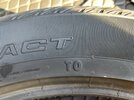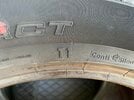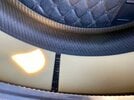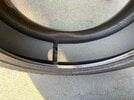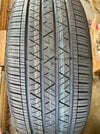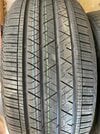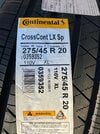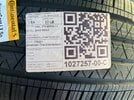Background
Recently purchased two NOS (new-old-stock) 2020 front tires at a bargain price for a pre-refresh Model X (see New 2020 20-inch Model X Tires). Hoped to find equivalent, matching rear tires, to build a second (back-up) 20-inch wheel-set. Wanted loose tires, since I may powder-coat some extra 20-inch staggered Slipstream rims I have before mounting the new tires.
Lesson and Observations
First looked ONLINE (e.g., Craig's List, eBay, Amazon, etc.) for bargains on new or near-new rear tires.
Postscript(s)
Not surprisingly, Continental (and other tire manufacturers like Michelin, Goodyear, etc) can issue mid-stream modifications/updates to original equipment tire models. Certain car-maker tire designations are updated numerically as needed--e.g., "T0" to "T1" to "T2"...--to indicate sequential changes to an OE tire that still meets the car-maker's original guidelines.
In this case the change to the Continental CrossContact LX Sport was most obviously to the acoustic foam. (I assume the denser foam is more efficient at road-noise reduction?) I suppose there could be other subtle, unseen tire changes, as well (e.g., to rubber composition or ply design).
As usual, I'm not the first to discuss these topics. For example, see Tyres with the designation 'TO'
BTW, there is (very minor) debate on whether it is "T0" (with a zero) or "TO" (with the letter "O"). Some say it is a zero, but many say it stands for "Tesla Original." Both interpretations make sense. Some car-manufacturer designations clearly do use the letter "O" (see list in Continental Original-Equipment Tires). So confusion is understandable. For Tesla, since the numerical sequence can be a real thing (as it is for the "N0", "N1" etc. series of Porsche), and the round symbol used is relatively narrow (if you look closely), my money is on it being a zero. Either way works.
I meant to include a poll on tire choice; here is one: Choice of Model X Tires.
Red Dot/Spot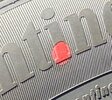
When I was visiting the brick-and-mortar tires stores I asked what the red dot meant on the sidewall of the Continental tires. Very few store employees I spoke to knew the answer. I am not 100% sure, but I've read (e.g., tires-easy.com) that it indicates the lightest point of a tire. If true the wheel's valve stem would be lined up with the red dot on the tire, but based on what I've seen few tire places bother to do that since tires are (harmonically) balanced anyway.
A more sophisticated story comes from this pdf document (for Continental UK and Irelandtires--note the different spellings) which may also be applicable for North American tires: "Coloured Dot" Markings on the Sidewall of Car Tyres. According to that 2013 publication the red dots (a) can easily wear off (so best to look for on new tires), (b) are mainly found on "OE" (original equipment) tires (supplied to Tesla and other car manufacturers), and (c) indicate the “radial force variation first harmonic maximum” (yipes!). It "shows the high point/stiff spot location" ( according to What RVF Means) and is measured for OEM tires supplied to car manufacturers in order to help guarantee new tire uniformity and reduce high-speed vibrations. I'm not a physicist or engineer, but I'm guessing this is determined with high speed spinning on sophisticated equipment? In this description, tire manufacturers would be sure to mount the red dot against the low spot on a wheel rim, therefore helping to ensure uniform roundness of the wheel-tire pair. OK.
Recently purchased two NOS (new-old-stock) 2020 front tires at a bargain price for a pre-refresh Model X (see New 2020 20-inch Model X Tires). Hoped to find equivalent, matching rear tires, to build a second (back-up) 20-inch wheel-set. Wanted loose tires, since I may powder-coat some extra 20-inch staggered Slipstream rims I have before mounting the new tires.
Lesson and Observations
First looked ONLINE (e.g., Craig's List, eBay, Amazon, etc.) for bargains on new or near-new rear tires.
- Most low-mileage tires for sale online are part of (take-off) sets of four, and...
- most come mounted on wheels (limiting the range of a practical search--shipping is expensive).
- Sales of used-tires only (no wheels) often involve professionally-repaired tires. (I wanted to avoid those.)
- At least one new-tire seller on eBay, with several warehouses across the U.S., might have had the tire I was looking for. But buying tires sight-unseen (they could/would not send specific photos or guarantee the tire year), and their "buyer-pays-for-return-shipping" policy was, imo, too risky.
- Surprisingly, the 2020 Tesla original-equipment Continental tire I was trying to match was, on paper, unavailable. As of 09/2021 Continental lists it as "sold out:" Continental CrossContact LX Sport (03547460000)
- Local retailers (who normally could order Continental original equipment tires for Tesla cars) were unable to reliably promise a tire to meet my minimum requirements—i.e., (a) "T0" designation, “Conti Silent” version, and original CrossContact LX Sport tread pattern. One store wanted to sell me a Porsche OE tire. (“N0” designation. Not cool. There is also a Mercedes-Benz [“MO”] version. See Continental Original-Equipment Tires.)
- Although there are many retail tire sellers, most apparently get their stock from a limited number of "middle-man" distributers, so I started hearing the same thing at each retailer--not available.
- In general tire-buying can be complicated. And making sense of the writing on tires is like reading Egyptian hieroglyphics. In order not to get stuck with a poor choice pushed on you by an assertive salesperson, try to brush up on tire information before-hand. There are several good sites for interpreting tire sidewall markings (for example, see Decoding the markings on the tire sidewall). Try to know exactly what it is that you need/want before entering a tire store.
- Using the Tesla App I first scheduled convenient mobile service drop-off of two new tires. Seemingly easy and simple. But through messaging it became clear that they couldn't be sure to exactly match rear tires to my existing front NOS tires.
- Luckily, via App messaging, the friendly Tesla staff person encouraged me to stop by the closest Tesla Service Center to inspect and purchase a pair of tires in person. Problem seemingly solved. (Having used only mobile service since getting the car in March, I wasn't aware that SCs were open again, or that they had in-person service desks.)
- But sadly, once at the shiny new Sacramento facility I was told by service desk staff that Tesla does not sell loose tires over the counter--that I would have to make an appointment (for following week) to have tires mounted and balanced, and that this was true at all the nearby Service Centers. I regretfully, and somewhat skeptically, made the appointment to have two tires mounted on wheels the following week. That purchase would of course include additional costs for mounting and balancing the two new tires.
- Fortunately for me, the Sacramento area now has at least three relatively nearby Service Centers (Sacramento [new], Rocklin, and Vallejo [new]). I immediately drove to the (very busy) Rocklin SC, where I was graciously received. Buy two tires over the counter? No problem. Inspect them first? Sure. Prefer 2020 tires? We can do that. They even cancelled my service appointment (at the first SC) for me, and I saved quite a bit by avoiding the mounting/balancing charges.
- As you can imagine, Model X tire stock at most SCs sees a high turnover. (Like an automotive version of Cookie Monster, Model X allegedly eats tires.) The tires both SCs had were slightly different (see below), but not in any way I could see that made a significant difference. So I was finally able to get what I wanted directly from Tesla, albeit at full retail price.
- Lesson? If you run into a roadblock at one Service Center, and have access, try a second. As with doctors, get a second opinion on important issues.
Characteristic | "Old" Front/Rear Tires | "New" Rear Tires |
|---|---|---|
Week/Year* | e.g., 26/2020 | 39/2020 |
Make - Model | Continental CrossContact LX Sport | Continental CrossContact LX Sport |
Size - Load/Speed Ratings | 275/45R20 110V | 275/45R20 110V |
Car-Manufacturer Original-Equipment Designation* | ||
Sound-reduction Technology* | ||
Tread Pattern | ||
Tread Depth (new) | 9/32" | 9/32" |
Continental SKU / Prod. Code / Article #* | 03547460000 | 03593520000(?) |
Tire Labels | - n/a - | |
*Observed Differences | ● Slightly older date of manufacture. ● "T0" sidewall designation. ● Acoustic foam strip is (a) tan, (b) wide & shallow, and (c) light-weight foam. ● Continental identification number. | ● More recent date of manufacture. ● "T1" sidewall designation. ● Acoustic foam strip is (a) gray, (b) narrow & deep, and (c) dense foam. ● Continental identification number (on label)? |
Postscript(s)
Not surprisingly, Continental (and other tire manufacturers like Michelin, Goodyear, etc) can issue mid-stream modifications/updates to original equipment tire models. Certain car-maker tire designations are updated numerically as needed--e.g., "T0" to "T1" to "T2"...--to indicate sequential changes to an OE tire that still meets the car-maker's original guidelines.
In this case the change to the Continental CrossContact LX Sport was most obviously to the acoustic foam. (I assume the denser foam is more efficient at road-noise reduction?) I suppose there could be other subtle, unseen tire changes, as well (e.g., to rubber composition or ply design).
As usual, I'm not the first to discuss these topics. For example, see Tyres with the designation 'TO'
BTW, there is (very minor) debate on whether it is "T0" (with a zero) or "TO" (with the letter "O"). Some say it is a zero, but many say it stands for "Tesla Original." Both interpretations make sense. Some car-manufacturer designations clearly do use the letter "O" (see list in Continental Original-Equipment Tires). So confusion is understandable. For Tesla, since the numerical sequence can be a real thing (as it is for the "N0", "N1" etc. series of Porsche), and the round symbol used is relatively narrow (if you look closely), my money is on it being a zero. Either way works.
I meant to include a poll on tire choice; here is one: Choice of Model X Tires.
Red Dot/Spot

When I was visiting the brick-and-mortar tires stores I asked what the red dot meant on the sidewall of the Continental tires. Very few store employees I spoke to knew the answer. I am not 100% sure, but I've read (e.g., tires-easy.com) that it indicates the lightest point of a tire. If true the wheel's valve stem would be lined up with the red dot on the tire, but based on what I've seen few tire places bother to do that since tires are (harmonically) balanced anyway.
A more sophisticated story comes from this pdf document (for Continental UK and Irelandtires--note the different spellings) which may also be applicable for North American tires: "Coloured Dot" Markings on the Sidewall of Car Tyres. According to that 2013 publication the red dots (a) can easily wear off (so best to look for on new tires), (b) are mainly found on "OE" (original equipment) tires (supplied to Tesla and other car manufacturers), and (c) indicate the “radial force variation first harmonic maximum” (yipes!). It "shows the high point/stiff spot location" ( according to What RVF Means) and is measured for OEM tires supplied to car manufacturers in order to help guarantee new tire uniformity and reduce high-speed vibrations. I'm not a physicist or engineer, but I'm guessing this is determined with high speed spinning on sophisticated equipment? In this description, tire manufacturers would be sure to mount the red dot against the low spot on a wheel rim, therefore helping to ensure uniform roundness of the wheel-tire pair. OK.
Last edited:



